Biology:Fraxinus platypoda
From HandWiki
Short description: Species of plant in the family Oleaceae
| Fraxinus platypoda | |
|---|---|

| |
| Leaves | |

| |
| Habit | |
| Scientific classification | |
| Kingdom: | Plantae |
| Clade: | Tracheophytes |
| Clade: | Angiosperms |
| Clade: | Eudicots |
| Clade: | Asterids |
| Order: | Lamiales |
| Family: | Oleaceae |
| Genus: | Fraxinus |
| Species: | F. platypoda
|
| Binomial name | |
| Fraxinus platypoda Oliv.
| |
| Synonyms[1] | |
|
List
| |
Fraxinus platypoda (syn. Fraxinus spaethiana), the Chinese red ash, is a species of flowering plant in the family Oleaceae, native to central China, and Japan.[1][2] In the latter stages of succession it often dominates the mountain riparian forest habitat in which it is found.[3]
It has high resistance to the emerald ash borer (Agrilus planipennis).[4] A slow-growing deciduous tree, it is used as a street tree in Aarhus, Denmark and Malmö, Sweden.[5]
References
- ↑ 1.0 1.1 "Fraxinus platypoda Oliv." (in en). Royal Botanic Gardens, Kew. http://www.plantsoftheworldonline.org/taxon/609162-1.
- ↑ Brown, Deborah J.G. (17 August 2016). "Fraxinus platypoda (Chinese Red Ash), leaf, summer". The Morton Arboretum. https://acorn.mortonarb.org/Detail/objects/57651.
- ↑ 深町, 篤子; 星野, 義延 (2021). "中央日本の山地渓畔林におけるネコノメソウ属の種の共存と選好性". 植生学会誌 38. doi:10.15031/vegsci.38.133.
- ↑ Kelly, Laura J.; Plumb, William J.; Carey, David W.; Mason, Mary E.; Cooper, Endymion D.; Crowther, William; Whittemore, Alan T.; Rossiter, Stephen J. et al. (2020). "Convergent molecular evolution among ash species resistant to the emerald ash borer". Nature Ecology & Evolution 4 (8): 1116–1128. doi:10.1038/s41559-020-1209-3. PMID 32451426.
- ↑ Ossola, Alessandro; Hoeppner, Malin J.; Burley, Hugh M.; Gallagher, Rachael V.; Beaumont, Linda J.; Leishman, Michelle R. (2020). "The Global Urban Tree Inventory: A database of the diverse tree flora that inhabits the world's cities". Global Ecology and Biogeography 29 (11): 1907–1914. doi:10.1111/geb.13169.
Wikidata ☰ {{{from}}} entry
 |




